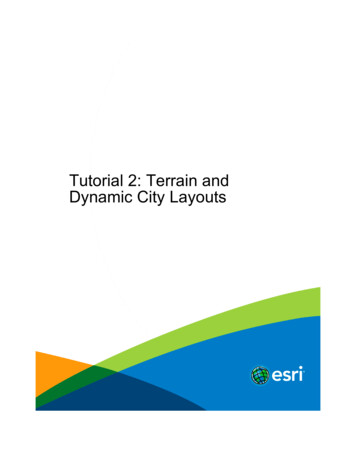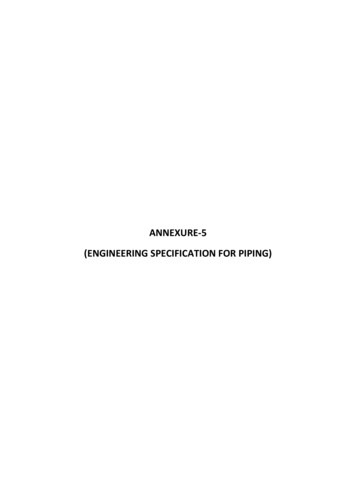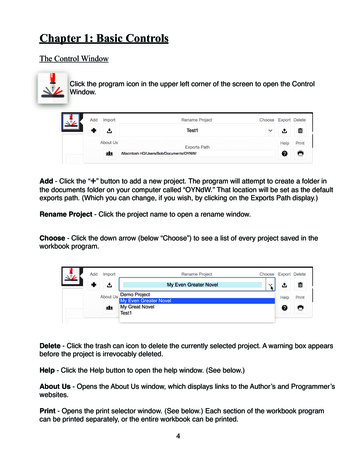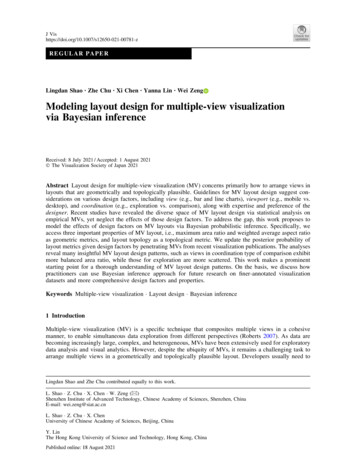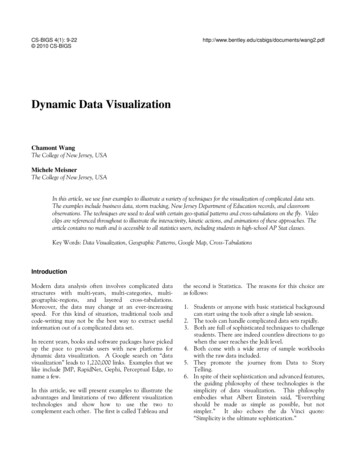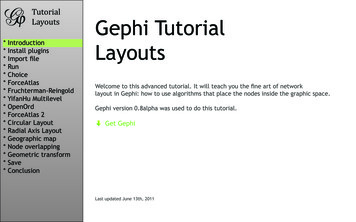
Transcription
TutorialLayouts* Introduction* Install plugins* Import file* Run* Choice* ForceAtlas* Fruchterman-Reingold* YifanHu Multilevel* OpenOrd* ForceAtlas 2* Circular Layout* Radial Axis Layout* Geographic map* Node overlapping* Geometric transform* Save* ConclusionGephi TutorialLayoutsWelcome to this advanced tutorial. It will teach you the fine art of networklayout in Gephi: how to use algorithms that place the nodes inside the graphic space.Gephi version 0.8alpha was used to do this tutorial.Get GephiLast updated June 13th, 2011
TutorialLayouts* Introduction* Install plugins* Import file* Run* Choice* ForceAtlas* Fruchterman-Reingold* YifanHu Multilevel* OpenOrd* ForceAtlas 2* Circular Layout* Radial Axis Layout* Geographic map* Node overlapping* Geometric transform* Save* ConclusionInstall layout pluginsWe need to install additional plugins. Go to the Tools menu and then Plugins. In the Available Plugins tab check:- OpenOrdLayout- CircularLayout- GeoLayout- Geometric Transformation- NoverlapLayout Click on Install. The plugins are installedand you are asked to reboot Gephi. ClickOK.
TutorialLayouts* Introduction* Install plugins* Import file* Run* Choice* ForceAtlas* Fruchterman-Reingold* YifanHu Multilevel* OpenOrd* ForceAtlas 2* Circular Layout* Radial Axis Layout* Geographic map* Node overlapping* Geometric transform* Save* ConclusionOpen Graph File Download the fileLesMiserables.gexf In the menubar, go to File Menu and Open. When your file is opened, the report sums up data found and any issues.- Number of nodes- Number of edges- Type of graph Click on OK to validate and see the graph.Graph Format-GEXFGraphMLPajek NETGDFGML- Tulip TLP- CSV- Netdraw VNA- Compressed ZIP/GZ
TutorialLayouts* Introduction* Install plugins* Import file* Run* Choice* ForceAtlas* Fruchterman-Reingold* YifanHu Multilevel* OpenOrd* ForceAtlas 2* Circular Layout* Radial Axis Layout* Geographic map* Node overlapping* Geometric transform* Save* ConclusionYou should now see a graphWe imported the “Les Miserables” dataset1. This is a coappearance weighted network ofcharacters in the novel “Les Miserables” from Victor Hugo.Node position is random at first, so you may see a slighty different representation.1D. E. Knuth, The Stanford GraphBase: A Platform for Combinatorial Computing, Addison-Wesley,Reading, MA (1993).
TutorialLayouts* Introduction* Install plugins* Import file* Run* Choice* ForceAtlas* Fruchterman-Reingold* YifanHu Multilevel* OpenOrd* ForceAtlas 2* Circular Layout* Radial Axis Layout* Geographic map* Node overlapping* Geometric transform* Save* ConclusionRun a layoutLayout algorithms set the graph shape, it is the most essential operation. Locate theLayout module, on the left panel. Choose “Force Atlas”You can see the layout properties below, leave defaultvalues. Click onto launch the algorithm. You see now the positions of nodes changing in real time.Layout algorithmsGraphs are usually laid out with “Force-based” algorithms. They follow a simple principle: linkednodes attract each other and non-linked nodes are pushed apart.
TutorialLayouts* Introduction* Install plugins* Import file* Run* Choice* ForceAtlas* Fruchterman-Reingold* YifanHu Multilevel* OpenOrd* ForceAtlas 2* Circular Layout* Radial Axis Layout* Geographic map* Node overlapping* Geometric transform* Save* ConclusionControl the layoutThe purpose of Layout Properties is to let you control the algorithm in order to make areadable representation. Set the “Repulsion strengh” at 10 000 to expandthe graph. Type “Enter” to validate the changed value. And nowTipsthe algorithm.Click on the icon“Center on Graph” on the bottom left of the Visualization panel if you don’tsee the graph anymore.
TutorialLayouts* Introduction* Install plugins* Import file* Run* Choice* ForceAtlas* Fruchterman-Reingold* YifanHu Multilevel* OpenOrd* ForceAtlas 2* Circular Layout* Radial Axis Layout* Geographic map* Node overlapping* Geometric transform* Save* ConclusionYou should now see a graph with the layout applied
TutorialLayouts* Introduction* Install plugins* Import file* Run* Choice* ForceAtlas* Fruchterman-Reingold* YifanHu Multilevel* OpenOrd* ForceAtlas 2* Circular Layout* Radial Axis Layout* Geographic map* Node overlapping* Geometric transform* Save* ConclusionPlay against the algorithm!Run the layout again and drag the nodes to stress it. LocateDragging action, in the top left of theVisualization panel. Ajust the selection diameter in the panel or byusing the shortcut “Ctrl Mouse Wheel”.Increase the “Autostab strength” in the Layout Properties to 100 000, then drag thenodes. The graph becomes less deformed. And nowthe algorithm.
TutorialLayouts* Introduction* Install plugins* Import file* Run* Choice* ForceAtlas* Fruchterman-Reingold* YifanHu Multilevel* OpenOrd* ForceAtlas 2* Circular Layout* Radial Axis Layout* Geographic map* Node overlapping* Geometric transform* Save* ConclusionVarious layouts existGephi implements various layout algorithms. They set the shape of the graph.OpenOrdForceAtlas 2Radial AxisGeoLayoutAirlines sample dataset: http://gephi.org/datasets/airlines-sample.gexf
TutorialLayouts* Introduction* Install plugins* Import file* Run* Choice* ForceAtlas* Fruchterman-Reingold* YifanHu Multilevel* OpenOrd* ForceAtlas 2* Circular Layout* Radial Axis Layout* Geographic map* Node overlapping* Geometric transform* Save* ConclusionSo how to choose a layout?In general, select one according to the feature of the topology you want to NTARITIESForceAtlas, Yifan RAPHICREPARTITIONCircular, Radial AxisGeoLayoutGraphic Adjustements- Label Adjust- Noverlap- Expansion- Contraction
TutorialLayouts* Introduction* Install plugins* Import file* Run* Choice* ForceAtlas* Fruchterman-Reingold* YifanHu Multilevel* OpenOrd* ForceAtlas 2* Circular Layout* Radial Axis Layout* Geographic map* Node overlapping* Geometric transform* Save* ConclusionForceAtlas layoutHome-brew layout of Gephi, it is made to spatialize Small-World / Scale-free networks.It is focused on quality (meaning “being useful to explore real data”) to allow a rigorous interpretation of the graph (e.g. in SNA) with the fewest biases possible, and a goodreadability even if it is slow.Author:Date:Kind:Complexity:Graph size:Use edge weight:Mathieu Jacomy2007Force-directedO(N²)1 to 10 000 nodesYes
TutorialLayouts* Introduction* Install plugins* Import file* Run* Choice* ForceAtlas* Fruchterman-Reingold* YifanHu Multilevel* OpenOrd* ForceAtlas 2* Circular Layout* Radial Axis Layout* Geographic map* Node overlapping* Geometric transform* Save* ConclusionRun ForceAtlasthe layout by applying the following settings step by step: Autostab strength 2 000Increase to move the nodes slowly. Repulsion strength 1 000How strongly does each node reject others. Attraction strength 1How strongly each pair of connected nodes attract each other. Gravity 100Attract all nodes to the center to avoid dispersion of disconnected components. Attraction Distrib. checkedPush hubs (high number of output links) at theperiphery and put authorities (high number of input links) more central.And nowthe algorithm.Adjust by SizesThis option avoids node overlapping, depending on the size of each node.
TutorialLayouts* Introduction* Install plugins* Import file* Run* Choice* ForceAtlas* Fruchterman-Reingold* YifanHu Multilevel* OpenOrd* ForceAtlas 2* Circular Layout* Radial Axis Layout* Geographic map* Node overlapping* Geometric transform* Save* ConclusionFruchterman-Reingold layoutIt simulates the graph as a system of mass particles. The nodes are the mass particles andthe edges are springs between the particles. The algorithms try to minimize the energyof this physical system. It has become a standard but remains very slow.Author:Date:Kind:Complexity:Graph size:Use edge weight:Thomas Fruchterman & Edward Reingold11991Force-directedO(N²)1 to 1 000 nodesNoFruchterman, T. M. J., & Reingold, E. M. (1991). Graph Drawing by Force-Directed Placement.Software: Practice and Experience, 21(11).1
TutorialLayouts* Introduction* Install plugins* Import file* Run* Choice* ForceAtlas* Fruchterman-Reingold* YifanHu Multilevel* OpenOrd* ForceAtlas 2* Circular Layout* Radial Axis Layout* Geographic map* Node overlapping* Geometric transform* Save* ConclusionRun Fruchterman-Reingoldthe layout by applying the following settings step by step: Area 100 Area 100 000Graph size area. Gravity 1 000 Gravity 100Attract all nodes to the center to avoid dispersionof disconnected components.And nowthe algorithm.Unstable nodes position!Sometimes the algorithm does not converge, resulting in an unstable graph. Reduce the “Speed”setting to gain precision.
TutorialLayouts* Introduction* Install plugins* Import file* Run* Choice* ForceAtlas* Fruchterman-Reingold* YifanHu Multilevel* OpenOrd* ForceAtlas 2* Circular Layout* Radial Axis Layout* Geographic map* Node overlapping* Geometric transform* Save* ConclusionYifan Hu Multilevel layoutIt is a very fast algorithm with a good quality on large graphs. It combines a force-directedmodel with a graph coarsening technique (multilevel algorithm) to reduce the complexity. The repulsive forces on one node from a cluster of distant nodes are approximated bya Barnes-Hut calculation, which treats them as one super-node. It stops automatically.Author:Date:Kind:Complexity:Graph size:Use edge weight:Yifan Hu12005Force-directed multilevelO(N*log(N))100 to 100 000 nodesNoY. F. Hu, Efficient and high quality force-directed graph drawing. The Mathematica Journal, 10(37-71), 2005.1
TutorialLayouts* Introduction* Install plugins* Import file* Run* Choice* ForceAtlas* Fruchterman-Reingold* YifanHu Multilevel* OpenOrd* ForceAtlas 2* Circular Layout* Radial Axis Layout* Geographic map* Node overlapping* Geometric transform* Save* ConclusionRun Yifan Hu MultilevelLaunch the layout by applying the following settings step by step: Step ratio 0.99Ratio used to update the step size. Increase it fora better quality (vs speed). Optimal distance 200Natural length of the springs. Increase it to placenodes farther apart. Theta 1.0Approximation for Barnes-Hut calculation. Smallervalues mean more accuracy.
TutorialLayouts* Introduction* Install plugins* Import file* Run* Choice* ForceAtlas* Fruchterman-Reingold* YifanHu Multilevel* OpenOrd* ForceAtlas 2* Circular Layout* Radial Axis Layout* Geographic map* Node overlapping* Geometric transform* Save* ConclusionOpenOrd layoutIt expects undirected weighted graphs and aims to better distinguish clusters. It can berun in parallel to speed up computing, and stops automatically. The algorithm is originally based on Frutcherman-Reingold and works with a fixed number of iterations controlledvia a simulated annealing type schedule (liquid, expansion, cool-down, crunch, andsimmer). Long edges are cut to allow clusters to separate.Author:Date:Kind:Complexity:Graph size:Use edge weight:S. Martin, W. M. Brown, R. Klavans, and K. Boyack12010 (VxOrd)Force-directed simulated annealingO(N*log(N))100 to 1 000 000 nodesYesS. Martin, W. M. Brown, R. Klavans, and K. Boyack, “OpenOrd: An Open-Source Toolbox forLarge Graph Layout,” SPIE Conference on Visualization and Data Analysis (VDA)., 20111
TutorialLayouts* Introduction* Install plugins* Import file* Run* Choice* ForceAtlas* Fruchterman-Reingold* YifanHu Multilevel* OpenOrd* ForceAtlas 2* Circular Layout* Radial Axis Layout* Geographic map* Node overlapping* Geometric transform* Save* ConclusionRun OpenOrdLaunch the layout by applying the following settings step by step: Edge cut 0.95 Num iterations 100 Num iterations 850 Random seed -6308261588084905834Fix node placementFrom 0 (standard Frutcherman-Reingold) to 1.Percentage of the greatest distance between twonodes in the drawing. A higher cutting means amore clustered result.Contract the clusters.Expand the clusters.Use this value to produce exactly the same shapeas shown before.Fix the position of a node (or a group of selected nodes) by “Right-click onit Settle”. It works for all layouts except Yifan Hu. For OpenOrd, use the“fixed time” setting on the Layout panel to configure the time the fixednodes will not move.
TutorialLayouts* Introduction* Install plugins* Import file* Run* Choice* ForceAtlas* Fruchterman-Reingold* YifanHu Multilevel* OpenOrd* ForceAtlas 2* Circular Layout* Radial Axis Layout* Geographic map* Node overlapping* Geometric transform* Save* ConclusionRun OpenOrd on a large graphOpenOrd is really helpful on large graphs. Import the fileinternet routers-22july06.gml.zipThis network has 22 963 nodes and 48 436 edges. It is a symmetrized snapshot of thestructure of the Internet at the level of autonomous systems, reconstructed from BGPtables posted by the University of Oregon Route Views Project. This snapshot was created by Mark Newman from data on July 22, 2006.If you have a multi-core computer:Increase the number of threads to execute it in parallel and therefore speed up the execution of the algorithm. It is recommended to set the number of core minus 1 to keepa thread for display. Set the “Num Threads” setting or leave default parameters. Click onand wait until it stops.OpenOrd executes in a finite number of iterations, so you can see the progress on thebottom-right of the screen.
TutorialLayouts* Introduction* Install plugins* Import file* Run* Choice* ForceAtlas* Fruchterman-Reingold* YifanHu Multilevel* OpenOrd* ForceAtlas 2* Circular Layout* Radial Axis Layout* Geographic map* Node overlapping* Geometric transform* Save* ConclusionYou should now see a graph with the layout applied
TutorialLayouts* Introduction* Install plugins* Import file* Run* Choice* ForceAtlas* Fruchterman-Reingold* YifanHu Multilevel* OpenOrd* ForceAtlas 2* Circular Layout* Radial Axis Layout* Geographic map* Node overlapping* Geometric transform* Save* ConclusionGo back to the previous workspaceWhen you imported the second dataset, a new workspace was automatically created.You are now in the “Workspace 2”. We go back now to the “Workspace 1” where thegraph of Les Miserables still exists. Locate the workspace switcher on the bottom-right of the screen. You see the name of the current workspace. Click on it and select “Workspace 1”. You can either click on the arrows to switch.
TutorialLayouts* Introduction* Install plugins* Import file* Run* Choice* ForceAtlas* Fruchterman-Reingold* YifanHu Multilevel* OpenOrd* ForceAtlas 2* Circular Layout* Radial Axis Layout* Geographic map* Node overlapping* Geometric transform* Save* ConclusionForceAtlas 2 layoutImproved version of the Force Atlas to handle large networks while keeping a very goodquality. Nodes repulsion is approximated with a Barnes-Hut calculation, which thereforereduces the algorithm complexity. Replace the “attraction” and “repulsion” forces by a“scaling” parameter.Author:Date:Kind:Complexity:Graph size:Use edge weight:1Mathieu Jacomy12011Force-directedO(N*log(N))1 to 1 000 000 version-of-our-home-brew-layout/
TutorialLayouts* Introduction* Install plugins* Import file* Run* Choice* ForceAtlas* Fruchterman-Reingold* YifanHu Multilevel* OpenOrd* ForceAtlas 2* Circular Layout* Radial Axis Layout* Geographic map* Node overlapping* Geometric transform* Save* ConclusionRun ForceAtlas 2the layout by applying the following settings step by step: LinLog mode checked LinLog mode uncheckedLinear attraction & logarithmic repulsion (lin-linby default), makes clusters tighter. Scaling 100Increase to make the graph sparser. Edge weight influence 0From 0 (no influence) to 1 (normal). Set 0 to calculate forces without edge weight.And nowthe algorithm.PerformanceActivate “Approximate Repulsion” on large graphs only, but let’stry it in this tutorial. Check it, set the “Tolerance” option to0.04 and run the algorithm to see how nodes are swinging!
TutorialLayouts* Introduction* Install plugins* Import file* Run* Choice* ForceAtlas* Fruchterman-Reingold* YifanHu Multilevel* OpenOrd* ForceAtlas 2* Circular Layout* Radial Axis Layout* Geographic map* Node overlapping* Geometric transform* Save* ConclusionCircular layoutIt draws nodes in a circle ordered by ID, a metric (degree, betweenness centrality.) orby an attribute. Use it to show a distribution of nodes with their links.Author:Date:Kind:Complexity:Graph size:1Matt Groeninger12010CircularO(N)1 to 1 000 000 nodeshttp://gephi.org/plugins/circular-layout/
TutorialLayouts* Introduction* Install plugins* Import file* Run* Choice* ForceAtlas* Fruchterman-Reingold* YifanHu Multilevel* OpenOrd* ForceAtlas 2* Circular Layout* Radial Axis Layout* Geographic map* Node overlapping* Geometric transform* Save* ConclusionRun Circular Layout Select the “Circular Layout” in theLayout panel. Set the “Order nodes by” setting to “Degree”. the layout. In theRanking panel, choose “Degree” as a rankparameter. Select the diamond icon in the toolbar for size. Set a min size at 10 and a max size at 50. Click on the layout again to avoid node overlap.to see the distribution of degree.
TutorialLayouts* Introduction* Install plugins* Import file* Run* Choice* ForceAtlas* Fruchterman-Reingold* YifanHu Multilevel* OpenOrd* ForceAtlas 2* Circular Layout* Radial Axis Layout* Geographic map* Node overlapping* Geometric transform* Save* ConclusionRadial Axis LayoutIt is provided with the Circular Layout plugin. It groups nodes and draws the groups inaxes (or spars) radiating outwards from a central circle. Groups are generated using ametric (degree, betweenness centrality.) or an attribute. Use it to study homophily byshowing distributions of nodes inside groups with their links.Author:Date:Kind:Complexity:Graph size:1Matt Groeninger12011CircularO(N)1 to 1 000 000 nodeshttp://gephi.org/plugins/circular-layout/
TutorialLayouts* Introduction* Install plugins* Import file* Run* Choice* ForceAtlas* Fruchterman-Reingold* YifanHu Multilevel* OpenOrd* ForceAtlas 2* Circular Layout* Radial Axis Layout* Geographic map* Node overlapping* Geometric transform* Save* ConclusionDetect communitiesWe now want to study the community structure in this network: does it divide naturallyinto groups of nodes with dense connections within groups and sparser connections between groups?In theStatistics panel, click onnear the “Modularity”1 line.The community detection algorithm created a “Modularity Class” value for each node.The partition module can use this new data to colorize communities. Locate thePartition module on the left panel. Click on the “Refresh” button to populate the partition list. Select “Modularity Class” in the partition list.You can see that 9 communities were found, could bedifferent for you. A random color has been set for eachcommunity identifier. Click onto colorize nodes.Blondel V, Guillaume J, Lambiotte R, Mech E (2008) Fast unfolding of communities in large networks. J Stat Mech: Theory Exp 2008:P10008. (http://findcommunities.googlepages.com)1
TutorialLayouts* Introduction* Install plugins* Import file* Run* Choice* ForceAtlas* Fruchterman-Reingold* YifanHu Multilevel* OpenOrd* ForceAtlas 2* Circular Layout* Radial Axis Layout* Geographic map* Node overlapping* Geometric transform* Save* ConclusionRun Radial Axis LayoutRun the layout by applying the following settings step by step: Group nodes by “Degree”Homophily by degree? Group nodes by “Modularity Class” Order nodes by “Degree”Distribution of nodes by degree insideeach community. Draw spar/axis as spiral checkedBetter show links inside communities Draw spar/axis as spiral unchecked Ascending order checkedBetter show links between communities
TutorialLayouts* Introduction* Install plugins* Import file* Run* Choice* ForceAtlas* Fruchterman-Reingold* YifanHu Multilevel* OpenOrd* ForceAtlas 2* Circular Layout* Radial Axis Layout* Geographic map* Node overlapping* Geometric transform* Save* ConclusionGeographic map with GeoLayoutThe GeoLayout uses latitude/longitude coordinates to set nodes position on the network.Several projections are available, including Mercator which is used by Google Maps andother online services. The two node attribute columns for coordinates should be in numeric format.Author:Date:Kind:Complexity:Graph size:1Alexis Jacomy12010GeographicO(N)1 to 1 000 000 gephi/
TutorialLayouts* Introduction* Install plugins* Import file* Run* Choice* ForceAtlas* Fruchterman-Reingold* YifanHu Multilevel* OpenOrd* ForceAtlas 2* Circular Layout* Radial Axis Layout* Geographic map* Node overlapping* Geometric transform* Save* ConclusionRun GeoLayout Download the fileairlines-sample.gexf and open it.The network is an undirected graph with 235 nodes and 1297edges. For each node there are two additional pieces of information - latitude and longitude, both expressed in degrees. Go to the Click onLayout module and choose “Geo Layout” in the list.
TutorialLayouts* Introduction* Install plugins* Import file* Run* Choice* ForceAtlas* Fruchterman-Reingold* YifanHu Multilevel* OpenOrd* ForceAtlas 2* Circular Layout* Radial Axis Layout* Geographic map* Node overlapping* Geometric transform* Save* ConclusionHow to avoid node overlap?Sometimes the layout is not completely satisfying, as big nodes can overlap smaller. Threedifferent techniques are available to avoid it.The “Force Atlas” algorithm has an option to take node size into account when applyinga layout. Go back to the Workspace 1. Choose “Force Atlas” on theLayout panel. Click on “Reset” at the bottom of the panel toreset the layout parameters.
TutorialLayouts* Introduction* Install plugins* Import file* Run* Choice* ForceAtlas* Fruchterman-Reingold* YifanHu Multilevel* OpenOrd* ForceAtlas 2* Circular Layout* Radial Axis Layout* Geographic map* Node overlapping* Geometric transform* Save* ConclusionHow to avoid node overlap? the algorithm. Check the “Adjust by Sizes” (“Prevent Overlap”in ForceAtlas 2) option and run it again for a shortmoment. Set the “Repulsion Strength” to 1 000. Set the “Autostab Strength” to 500. the algorithm.You can see nodes are not overlapping anymore.Instability!This option makes node positions very unstable and disturbs the layout process. Use it at the end ofthe layout to refine it.
TutorialLayouts* Introduction* Install plugins* Import file* Run* Choice* ForceAtlas* Fruchterman-Reingold* YifanHu Multilevel* OpenOrd* ForceAtlas 2* Circular Layout* Radial Axis Layout* Geographic map* Node overlapping* Geometric transform* Save* ConclusionNoverlap layoutUse it after any layout to prevent node overlap while keeping the shape of the graph. Itis optimized for big graphs. First, run the “YifanHu” layout. Select the “Noverlap” algorithm and run it until it stops. Reduce the “speed” setting to 0.1 to increase quality. Increase the “ratio” at 2 and “margin” at 10 for morespacing around nodes.You can see nodes are notoverlapping anymore.
TutorialLayouts* Introduction* Install plugins* Import file* Run* Choice* ForceAtlas* Fruchterman-Reingold* YifanHu Multilevel* OpenOrd* ForceAtlas 2* Circular Layout* Radial Axis Layout* Geographic map* Node overlapping* Geometric transform* Save* ConclusionLabel Adjust layoutIt works on text size to repulse nodes and therefore makes every label readable. It onlyruns on the visible nodes in the Visualization panel. Locate the Visualization settings. Click onto activate text display. Increase the text size to the maximum. Go to theLayout panel. Select the “Label Adjust” algorithm and run it until it stops.
TutorialLayouts* Introduction* Install plugins* Import file* Run* Choice* ForceAtlas* Fruchterman-Reingold* YifanHu Multilevel* OpenOrd* ForceAtlas 2* Circular Layout* Radial Axis Layout* Geographic map* Node overlapping* Geometric transform* Save* ConclusionGeometric transformationsThere is no North-South-East-West directions for layouts, and distances are always relative. The same layout on the same graph can produce shapes with different orientationsand scale. Transformation are sometimes useful to compare laid out graphs.Use the following layouts to do basic transformations on the graph: “Clockwise Rotate” with angle -90 “Counter-Clockwise Rotate” with angle 45 “Expansion” with scale factor 1.2 “Contraction” with scale factor 0.8Transformation layoutThe plugin “Geometric Transformation” allows to combine rotations, homothetic transformationsand translations at the same time.
TutorialLayouts* Introduction* Install plugins* Import file* Run* Choice* ForceAtlas* Fruchterman-Reingold* YifanHu Multilevel* OpenOrd* ForceAtlas 2* Circular Layout* Radial Axis Layout* Geographic map* Node overlapping* Geometric transform* Save* ConclusionSave your projectSaving your project encapsulates all data and results in a singlesession file.
TutorialLayouts* Introduction* Install plugins* Import file* Run* Choice* ForceAtlas* Fruchterman-Reingold* YifanHu Multilevel* OpenOrd* ForceAtlas 2* Circular Layout* Radial Axis Layout* Geographic map* Node overlapping* Geometric transform* Save* ConclusionConclusionIn this tutorial you learned how to use various layouts in Gephi according to the featureyou want to emphasis in the topology and the size of the network, how to avoid nodeoverlapping and how to do some geometric transformations.Other layout plugins are available through the Gephi Plugins Center.Go further: Gephi Website Gephi Wiki Gephi forum
Tutorial Layouts Open Graph File Download the file LesMiserables.gexf In the menubar, go to File Menu and Open. Graph Format - GEXF - GraphML - Pajek NET
